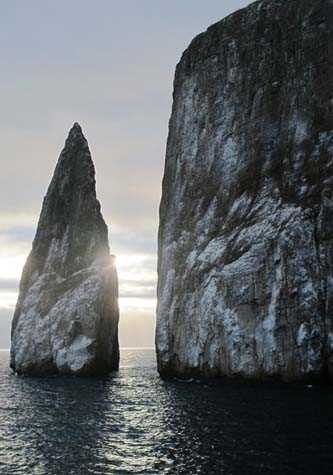The first Galápagos stretch of coastline that the crew of the HMS Beagle spotted was the high slopes of Punta Pitt. This area, with tall cliffs of yellowish tuff rock, is the remnants of some very old volcanic craters. Little vegetation has colonized Punta Pitt as it is constantly battered by the southeastern trades, but whatever little there may be can be used by nesting red-footed boobies.
Out of our three resident booby species, these are the only ones that have prehensile feet; therefore they perch on the branches of trees and bushes, adding a colorful note to the otherwise dry and dull-looking vegetation. The red-footed boobies were quite busy today as it seems like these were the beginnings of a new breeding season in the colony; their mating calls echoed in the walls of the cliffs, and several of them circled in the air, showing off their bright red feet to their newly-chosen partners.
Magnificent and great frigates also nest on the vegetation, and it is quite odd to see them perching so close to other birds species; after all, frigates are known to be the pirates of the air and often steal the fish caught by other seabirds. The end part of the trail is quite stunning with the colorful Sesuvium or Galápagos carpetweed; Nazca boobies seemed to fly in large flocks close to the rocky shores, with the vast blue-grey ocean as a background. We returned back to the landing beach along the canyon formed by torrents of water throughout hundreds of rainy seasons; then, there was time to relax at the beach where some Galápagos sea lions slept. The waters of this little bay were constantly patrolled by its ‘owner,’ a young male sea lion; that was, until we realized that the real master of the bay, who seemed to have been briefly away, chased the young ‘impostor’! The sun shone through the passing clouds making the tiny crystals of olivine sparkle in the sand and the sea turned blue. The colors were magnificent but we had to return to the ship to continue with our navigation further south along San Cristobal Island.
In the afternoon our ship stopped next to Kicker Rock. Quite separated from the coast, this impressive rock was once a tuff cone. Its walls are steep and therefore inaccessible to terrestrial animals, so it has become a heaven for seabirds. This is also one of the designated marine sites of the Galápagos, so snorkeling here can be quite spectacular: hundreds of different species of colorful marine invertebrates cover the walls including sponges, anemones, sea urchins, and sea stars. The marine currents that reach Kicker Rock make this a very productive area where large schools of fish and other creatures congregate. Sea turtles also find plenty to eat here, as well as spotted eagle rays and sharks like the Galápagos and black-tipped.
In the latter part of the afternoon we circumnavigated Kicker Rock to appreciate its size as well as its amazing wildlife once more. Frigates, Galápagos shearwaters, blue-footed and Nazca boobies, brown noddies and brown pelicans, swallow-tailed gulls, and red-billed tropic birds find a safe nesting and perching place here, totally safe from any land predators. The day was coming to an end, and so was our fantastic expedition in the Galápagos Islands. At sunset and with the silhouette of Kicker Rock illuminated by a beautiful yellow light we realized what a privilege it is to be here in this one of the last paradises on Earth, the Enchanted Islands.







